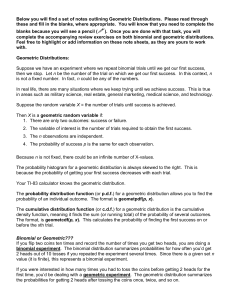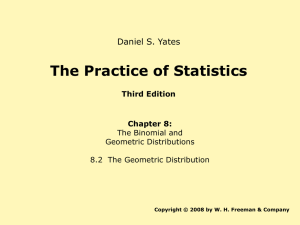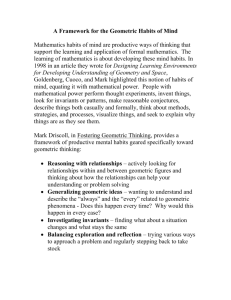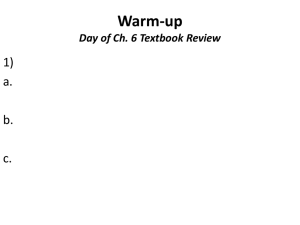Geometric Packet Answers
advertisement
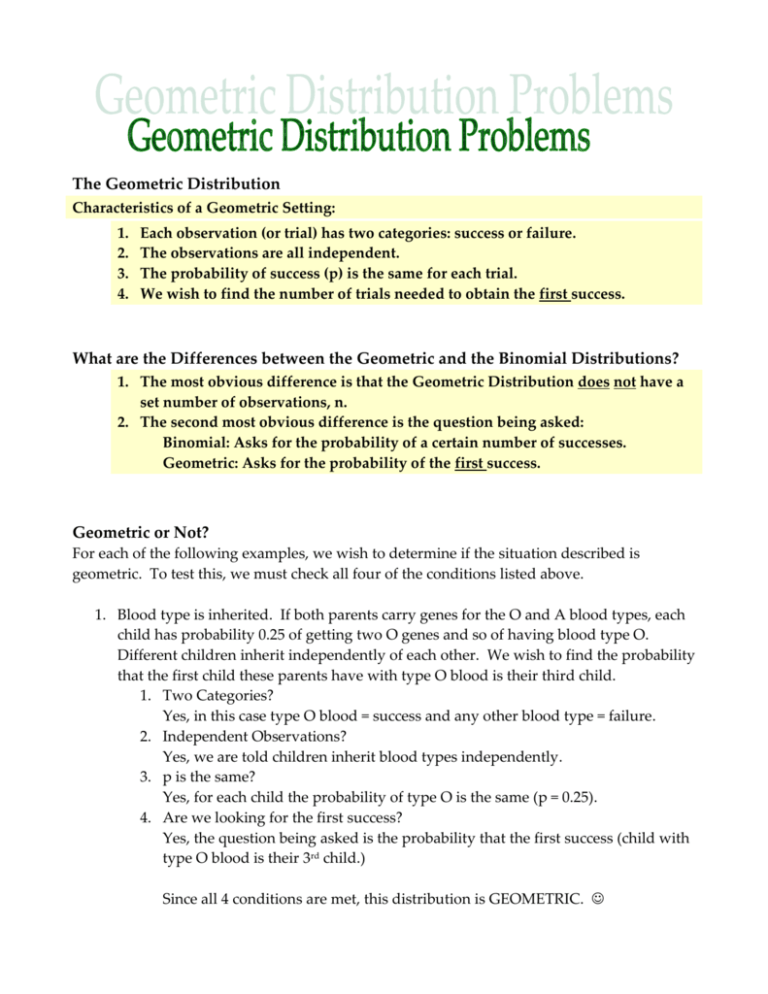
The Geometric Distribution Characteristics of a Geometric Setting: 1. 2. 3. 4. Each observation (or trial) has two categories: success or failure. The observations are all independent. The probability of success (p) is the same for each trial. We wish to find the number of trials needed to obtain the first success. What are the Differences between the Geometric and the Binomial Distributions? 1. The most obvious difference is that the Geometric Distribution does not have a set number of observations, n. 2. The second most obvious difference is the question being asked: Binomial: Asks for the probability of a certain number of successes. Geometric: Asks for the probability of the first success. Geometric or Not? For each of the following examples, we wish to determine if the situation described is geometric. To test this, we must check all four of the conditions listed above. 1. Blood type is inherited. If both parents carry genes for the O and A blood types, each child has probability 0.25 of getting two O genes and so of having blood type O. Different children inherit independently of each other. We wish to find the probability that the first child these parents have with type O blood is their third child. 1. Two Categories? Yes, in this case type O blood = success and any other blood type = failure. 2. Independent Observations? Yes, we are told children inherit blood types independently. 3. p is the same? Yes, for each child the probability of type O is the same (p = 0.25). 4. Are we looking for the first success? Yes, the question being asked is the probability that the first success (child with type O blood is their 3rd child.) Since all 4 conditions are met, this distribution is GEOMETRIC. Geometric or Not? (continued from previous pg) 2. There are 20 red marbles, 10 blue marbles, and 5 white marbles in a jar. Select a marble without looking, note the color, and then replace the marble in the jar. We’re interested in the number of marbles you would have to draw in order to be sure you have a red marble. 1. Two Categories? Yes, in this case type red marble = success and any other color = failure. 2. Independent Observations? Yes, we are drawing blindly and replacing the marbles – so results are independent. 3. p is the same? Yes, for each trial p = 20/35. 4. Are we looking for the first success? Yes, we are looking for the number of trials before we obtain the first red marble. Since all 4 conditions are met, this distribution is GEOMETRIC. 3. You want to know what percent of married people believe that mothers of young children should not be employed outside their home. You plan to interview 50 people, and for the sake of convenience you decide to interview both the husband and wife in 25 married couples. The random variable X is the number among the 50 persons interviewed who think mothers should not be employed. 1. Two Categories? Yes, in this case type success = thinking mothers should not be employed and failure = thinking they should be employed. 2. Independent Observations? No, we cannot expect the opinions of husband and wife to be independent. Since the independence condition failed, we know this distribution is NOT GEOMETRIC. Note: If the trials had been independent, we still would not have a geometric distribution as we are looking for the number of people who think mothers should not be employed (instead of the first person who agrees with this statement.) Your Turn: Geometric or Not? Using the three previous examples as models, determine if each of the following scenarios describe geometric distributions or not. If the distribution is not geometric, explain why it is not. If it is geometric, you need to list and verify that the four conditions are met. (If a distribution is not geometric, but it is binomial – please list this.) 1. In some cultures, it is considered very important to have a son to carry on the family name. Suppose that a couple in one of these cultures plans to have children until they have a son. Yes - We assume the gender of children born to a family are independent with p = 0.5 Success = son & failure = girl (Pg 552) 2. Carla makes random guesses on a multiple-choice test, with five choices per question. We want to know how many questions Carla guesses until she gets one correct. Yes -Success = correct answer p = 0.20 Trials are independent Looking for # of trials until we reach our first success 3. Carla continues to make random guesses on the multiple-choice test described in #2. If there are a total of 25 questions on the test, what is the probability that she answers exactly 20 questions correctly? NOT Geometric Since we are given a set # of trials (n = 25) & are looking for a specific number of successes (x = 20), this distribution is binomial & NOT geometric. Dir: If the distribution is not geometric, explain why it is not. If it is geometric, you need to list and verify that the four conditions are met. (If a distribution is not geometric, but it is binomial – please list this.) 4. The pool of potential jurors for a murder case contains 100 persons chosen at random form the adult residents of a large city. Each person in the pool is asked whether he or she opposes the dealth penalty. We are interested in the number of jurors we must interview before we obtain the first “yes.” Assume p is the same for all people. YES Two Categories: success = juror says ‘yes’ & failure = juror does not say yes Set probability of success, p Safe to assume trials are independent We are looking for the first success 5. At peak periods, 15% of attempted log-ins to an email service fail. Log-in attempts are independent and each has the same probability of failing. Darci logs in repeatedly until she succeeds. We are interested in the number of attempts she makes before successfully logging into her account. YES Two Categories: success = logs into account & failure = does not log in Set probability of success, p Told trials are independent We are looking for the first success 6. A student studies binomial distributions using computer-assisted instruction. After the lesson, the computer presents 10 problems. The student solves each problem and enters her answer. The computer gives additional instruction between problems if the answer is wrong. We are interested in the number of problems that the students answers correctly. NO; fails independence as additional instruction is provided Finding Geometric Probabilities in the TI-83/TI-84 Geompdf: Located in the listing with normalcdf, invnorm, binompdf, and binomcdf (2nd Vars) Used when we want to find the probability of obtaining our first success with a specific numbered trial. Used with problems of the type P(x = 3). This means our first success is on trial #3. “pdf” = probability distribution function. Geompdf(p, r) Select geompdf from the calculator list. In the open parenthesis, we enter p, r. p = probability of success r = number of trials until the first success Example: Among employed women, 25% have never been married. Suppose we randomly sample women in a particular business office. 1. What is the probability that the first woman who says she has never been married is the fourth woman I sample? 2. What is the probability that I sample 5 women before finding one who has never been married? Notes & Answers: We have a geometric distribution with p = .25. In #1, we wish to find the probability that our first success occurs on the 2nd attempt, so r = 2. Use the calculator to enter: Geompdf(0.25, 4) Our Answer is: 0.1875 In #2, we sample 5 women before obtaining the first success. Thus r = 5. Use the calculator to enter Geompdf(0.25, 5) Our Answer is: 0.0791 Geometric “pdf” Practice Problems: Use the geometric pdf function in your graphing calculator to answer each of the following questions. Be sure to include “geompdf(p, r)” with the appropriate numbers for p and r with your answer. 1. Blood type is inherited. If both parents carry genes for the O and A blood types, each child has probability 0.25 of getting two O genes and so of having blood type O. Different children inherit independently of each other. We wish to find the probability that the first child these parents have with type O blood is their third child. P(x = 3) = geometpdf(0.25, 3) = 0.1406 2. A basketball player makes 80% of her free throws. We put her on the free-throw line and ask her to shoot free throws until she misses. Let X = the number of free throws the player takes until she misses. a. What is p? (Be careful. We are looking for the # of free throws until she misses….) p = 0.20 b. Assuming that her shots are independent, what is the probability that she will make 5 shots before she misses? Note: we are looking for her first missed shot to be shot #6 P(x = 6) = geometpdf(0.2, 6) = 0.0655 c. What is the probability that she misses her first free throw? P(x = 1) = geometpdf(.2, 1) = 0.2 3. The State Department is trying to identify an individual who speaks Farsi to fill a foreign embassy position. They have determined that 4% of the applicant pool are fluent in Farsi. a. What is the probability that they will find the first Farsi speaking applicant on the 25th interview? P(x = 25) = geometpdf(.04, 25) = 0.015 b. On the 40th? P(x = 40) = geometpdf(.04, 40) = 0.008 4. Carla makes random guesses on her Statistics multiple-choice test, which has five choices for each question. We want to know how many questions Carla answers until she gets one correct? a. Define a success in this context and define the random variable X of interest. What is the probability of success? Success = answering question correctly P = 0.2 b. What is the probability that Carla’s first correct answer occurs on Question 5? P(x = 5) = geometpdf(.2, 5) = 0.08192 c. What is the probability that Carla’s first correct answer occurs on Question 7? P(x = 7) = geometpdf(.2, 7) = 0.0524 Geomcdf: Use when we want to find the probability that our first success occurs within a specified number of trials. Problems of the type P(x < 3) “cdf” = cumulative distribution function Geomcdf(p, r) Select geomcdf from the calculator list. In the open parenthesis, we enter p, r. p = probability of success r = desired number of successes Important Note: Geomcdf only finds the probability that our first success occurs within a specified number of trials – the # of trials is less than or equal to the desired value. It always finds P(x < r). Be Careful in wording your problems. If you want the probability that the number of trials needed to obtain our first success is less than 2, you must find P(x < 1). Example: Among employed women, 25% have never been married. 1. What is the probability that we find the first never-married woman within the first 5 we sample? 2. What is the probability that we sample at most 2 women before finding one who has never been married? Notes & Answers: We have a geometric distribution with p = .25. In #1, we wish to find the prob. that the number of trials to obtain success is less than or equal to 5, i.e., P(x < 5.) In the calculator enter: Geomcdf(0.25, 5) Our Answer is: 0.7627 In #2, we want the number our first success to occur within the first two trials, P(x < 2). In the calculator enter: Geomcdf(0.25, 2) Our Answer is: 0.4375 Geometric “cdf” Practice Problems: 1. The count of children with type O blood among parents that carry genes for both O and the A blood type follows a geometric distribution with p = 0.25. Suppose a couple (meeting the above characteristics) plans to have children until they have a child with type O blood. a. Find the probability the couple has at most 3 children. P(x < 3) = geometcdf(0.25, 3) = 0.578 b. Use the complement rule to find the probability that the couple will have more than 3 children before having one with type O blood. 1 – 0.578 = 0.422 2. A basketball player makes 80% of her free throws. We put her on the free-throw line and ask her to shoot free throws until she misses. Let X = the number of free throws the player takes until she misses. a. What is the probability that the player misses her first free throw within the first 3 attempts? P(x < 3) = geometcdf(0.2, 3) = 0.488 b. What is the probability that her first miss will not occur within the first 3 attempts? P(x > 3) = 1 – 0.488 = 0.512 c. What is the probability that she will not miss a shot within her first 5 attempts? P(x > 5) = 1 – geometcdf(0.2, 5) = 0.3277 3. The State Department is trying to identify an individual who speaks Farsi to fill a foreign embassy position. They have determined that 4% of the applicant pool are fluent in Farsi. a. What is the probability that they will find the first Farsi speaking individual within the first 25 applicants? P(x < 25) = geometcdf(.04, 25) = 0.6396 b. Use your answer from part a to determine the probability that they will have to interview more than 25 until they find one who speaks Farsi. P(x > 25) = 1 – geometcdf(.04, 25) = 1 – 0.6396 = 0.3604 c. What is the probability that they will need to interview more than 40 applicants before finding one who speaks Farsi? P(x > 40) = 1 – geometcdf(0.4, 40) = 0.1954 4. Carla makes random guesses on her Statistics multiple-choice test, which has five choices for each question. We want to know how many questions Carla answers until she gets one correct? a. What is the probability that Carla’s first correct answer occurs within the first 6 questions? P(x < 6) geometcdf(.2, 6) = 0.7379 b. What is the probability that Carla’s first correct answer occurs within the first ten questions? P(x < 10) = geometcdf(.2, 10) = 0.8926 c. What is the probability that Carla must answer more than 10 questions before obtaining a correct answer? P(x > 10) = 1 – 0.8926 = 0.1074 Mixing it Up: The following problems review all that you have learned in this packet. The problems are mixed together, so you will need to think about them before plugging numbers into your calculator. 1. According to a 2000 study by the Bureau of Justice Statistics, approximately 2% of the nation’s 72 million children had a parent behind bars – nearly 1.5 million minors. a. Does X satisfy the requirements for a geometric setting? If so, what is p? Yes, if we are looking for the first success (incarcerated parent) p = 0.02 b. Describe P(X = 0) in words. This is the probability that we find our first incarcerated parent with the 0th person that we interview. c. Find P(X = 0). There is no such probability. This does not make sense in a geometric distribution d. Find P(X = 1). Geometpdf(0.02, 1) = .02 e. Describe P(X < 2) in words. This is the probability that we find our first incarcerated parent within the first two parents we interview. f. Find P(X < 2). Geometcdf(.02, 2) = .0396 g. Use your answer to part f, to find the probability that we do not find a child with an incarcerated parent within the first two children we interview. 1 - .0396 = 0.9604 2. Suppose that Erin guesses on each question of a multiple-choice quiz. a. If each question has four different choices, find the probability that Erin gets her first correct answer on her second question. P(x = 2) = geometpdf(.25, 2) = 0.1875 b. If each question has four different choices, find the probability that Erin’s first correct answer occurs within the first 5 problems. P(x < 5) = geometcdf(.25, 5) = 0.7627 c. If each question has five choices, find the probability that Erin i. Answers the first question correctly. P(x = 1) = geometpdf(0.2, 1) = 0.2 ii. Does not answer a question correctly within the first 5 questions. P(x > 5) = 1 – geometcdf(0.2, 5) = 0.3277 3. In a test for ESP (extrasensory perception), a subject is told that cards the experimenter can see but the subject cannot contain a star, a circle, a wave, or a square. As the experimenter looks at each card in turn, the subject names the shape on the card. A subject who is just guessing has probability 0.25 of guessing correctly on each card. a. The count of guesses has a geometric distribution. What is p? P = 0.25 b. What is the probability of the subject obtaining his/her first correct guess on the 4th question? P(x = 4) = geometpdf(.25, 4) = 0.1055 c. What is the probability of the subject obtaining his/her first correct guess within the first 4 questions? P( x < 4) = geometcdf(.25, 4) = 0.6836


